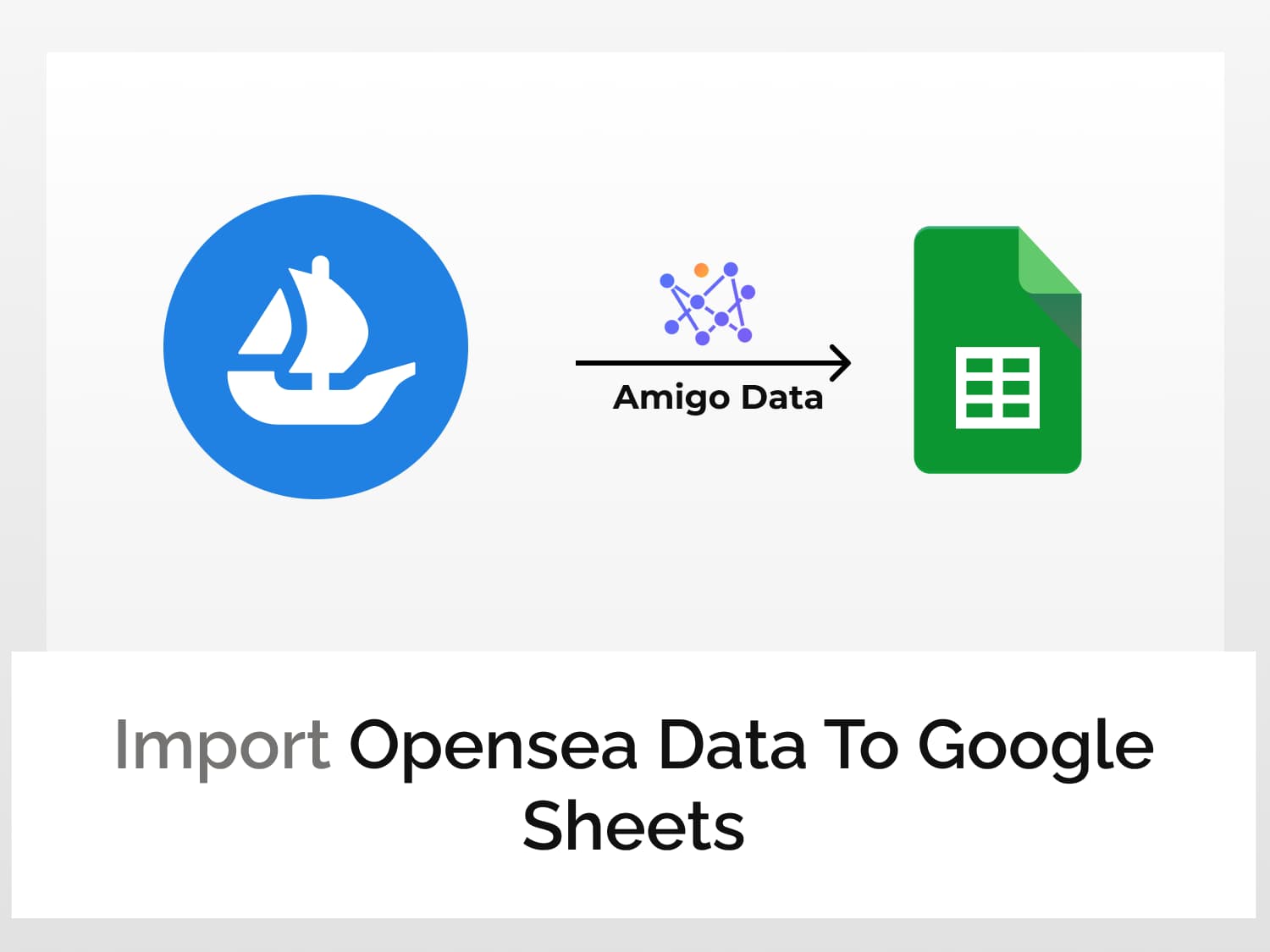In this article, we’ll learn how to import OpenSea data to Google Sheets. We can import OpenSea data such as assets, collections, contracts, listings and offers for an asset, and list of events that occur on assets that OpenSea tracks amongst other types of data.
We’ll use an extension in Google Sheets–Amigo Data–to pull OpenSea data to Google Sheets. With it we can integrate OpenSea into Google Sheets and retrieve data from OpenSea and pull the data automatically.

Read on to know how to import OpenSea data to Google Sheets. Following are the steps to import OpenSea data to Google Sheets.
How to import OpenSea data to Google Sheets
A step-by-step guide on how to import OpenSea data to Google Sheets using OpenSea API.
Install the Amigo Data extension in Google Sheets
Install the Amigo Data Google Sheets add-on from the Google Workspace Marketplace.
Click here to install.

Alternatively, you can get it from Google Sheets.
- Open a new sheet
- Go to Extensions→Add-ons→Get add-ons
- Search for Amigo Data and install
Get the OpenSea API endpoint URL
We’ll use an unofficial but simplified OpenSea API on RapidAPI to retrieve OpenSea data such as collections, assets, and contracts and import the data from OpenSea to Google Sheets.
Sign up or log in to RapidAPI.
Once you’re logged in, go to the OpenSea API documentation page in RapidAPI.
Click on the Subscribe to Test button and subscribe to a plan of your choice to use the OpenSea API.

On subscribing to a plan, an API key will be generated, which is used to authenticate API calls to RapidAPI.
Click Endpoints to go back to the API Playground. On the left is the list of the available endpoints that we can use to import OpenSea data to Google Sheets. Select any one, for example Assets to retrieve assets data from OpenSea.

Fill in the optional parameters if you need to filter the results and fetch data for a specific collection, or from a particular owner, or set a limit of the results.
The parameters for the example shown below will return the list of assets for collection with slug name “cryptopunks”, sort in descending order and fetch 30 results.

Click the Test Endpoint button to verify if the parameters are valid. If they are, a success message will appear under the Results section on the right side of the screen.
Under the Code Snippets section, we’ll find the OpenSea API URL along with the parameters and the headers.
Change the language to Shell→cURL. The query parameters are appended in the URL so that we do not have to enter the parameters manually. Copy the URL and also note the headers. These will be used fetch OpenSea data to Google Sheets.

Import the data to Google Sheets
Open Google Sheets and launch Amigo Data to pull OpenSea data to Google Sheets. To connect to Amigo Data, click Extensions→Amigo Data→Connect.

You’ll be presented with a list of sources to connect to. Choose Custom API.

Enter the OpenSea API endpoint URL in the API URL field. Do not include the apostrophes.

Then expand the Details tab and enter the headers mentioned in the Code Snippets.
Name: X-RapidAPI-Key, Value: YOUR_API_KEY
Name: X-RapidAPI-Host, Value: opensea13.p.rapidapi.com

Click the PREVIEW button. Flatten and expand the nested datasets and delete the columns that are not required. Then click IMPORT.

The data from OpenSea will be imported into Google Sheets in a moment. Below is a snippet of the imported data.

Automatically pull data from OpenSea to Google Sheets
You can likewise import the rest of the data types from OpenSea. Once the data have been imported into Google Sheets, they can be updated automatically at regular intervals–hourly, daily, weekly or on custom days–should you so wish, and get these data sent to your inbox. Click here to learn how to set a refresh schedule and set up alerts in Amigo Data.
Visit our blog to find out about the kinds of data that you can import to Google Sheets and how you can track stock and other financial data from Google Sheets.
FAQs
How do I scrape an OpenSea collection?
You can scrape an OpenSea collection with OpenSea API and import the OpenSea collections data to Google Sheets using Amigo.
To scrape an OpenSea collection, follow these steps:
- Go to the OpenSea API documentation.
- Select the Single Collection endpoint.
- Enter the collection slug in the parameter field.
- Get the endpoint URL and headers.
- Import the data to Google Sheets using Amigo Data.
Can I track an NFT from Google Sheets?
Yes, you can track NFTs from Google Sheets. Import the assets you want to track to Google Sheets using Amigo using the relevant asset endpoints. Then set a refresh schedule so that the data are updated automatically, allowing you to track NFTs live from Google Sheets.
Why do I get a “No data” error?
This is a common error and happens mostly because the number API calls a user has made exceeded the limit the plan he/she is subscribed to. Other possible reasons include incorrect endpoint URL and not adding the API headers.
Some recommended articles:
Automate Importing Financial Market Data To Google Sheets Using Polygon.io API
Get Real-Time Crypto Prices In Google Sheets With Live Coin Watch API
